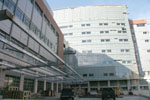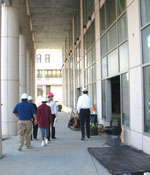MUSC's new hospital
Facility on Courtenay
Drive offers aesthetics, ease for patients
In
addition to installing the latest health care technologies and design
concepts, the new hospital aims to become one of the most
patient-centered health care facilities in South Carolina.So, what does patient-centered healing mean? Is it about providing easy access to services? Is it making it easy for patients to find their way around? Is it providing places of escape and comfort in an intense, high-tech setting? In order to call a facility patient-centered, the space must provide all these qualities, and the facility under construction on Courtenay Drive promises to live up to these expectations and more.
 The Courtenay
facility's front entrance will offer convenience in addition to
aesthetic characteristics.
The Courtenay
facility's front entrance will offer convenience in addition to
aesthetic characteristics.An enormous structure, the Phase I facility occupies 641,000-square-feet and was designed to accent the Charleston skyline with its aesthetic architecture and homage to the city’s historical roots. For example, the patient tower housing 156 beds is reminiscent of a sail, reminding all of Charleston’s nautical past and serving as a beacon for the future. In addition to the arrival garden that will complement a three-car wide horseshoe and pedestrian walkway, many characteristics of this facility will not only translate into pleasant patient experiences, but also will tackle some important issues facing hospital systems nationwide.
Healing hospitality
Gone are the days of assembly-line health care where patients felt like little more than cogs in the wheels of the great health care machine. Patient-centered care and a customer service attitude place MUSC at the forefront of a shift in thinking when it comes to today’s patient. As in all current MUSC facilities, health care professionals in the new hospital will continue to deliver high quality health care. Where the new hospital steps outside the bounds of tradition is by delivering a physical environment that is above all else, non-institutional.
 Ginny Gamble
explains to bioengineering staff during their tour of the new facility
how nursing stations throughout the hospital will be highlighted with
blonde wood accents so patients and staff can find them easily.
Ginny Gamble
explains to bioengineering staff during their tour of the new facility
how nursing stations throughout the hospital will be highlighted with
blonde wood accents so patients and staff can find them easily. Patients may be initially surprised at the concierge service, valet parking, and retail shops that have been a part of luxury industries for years. Another pleasant surprise will be the bridged parking area and covered walkways leading to the front door where a 6,000-square-foot conservatory will provide a soothing presence with the incorporation of lush vegetation and natural light.
 Each bed in the
acute care rooms in the Courtenay facility will help disguise medical
equipment, thus promoting a non-institutional atmosphere.
Each bed in the
acute care rooms in the Courtenay facility will help disguise medical
equipment, thus promoting a non-institutional atmosphere.Like a luxury hotel, each patient will have a private, 340-square-foot room with either a view of the Ashley River, historic downtown Charleston, or the conservatory. General acute care rooms also have a full bathroom. A dedicated space within each patient room includes a sitting and sleeping area. Work desks with both wired and wireless internet access will make it possible to support a loved one and stay connected to an ever busy life. The facility also includes 22 bariatric-friendly rooms dispersed throughout the seven-story patient tower, and all patient rooms are designed to integrate medical equipment into the background of the room instead of that equipment becoming the most prominent feature. The curved corridor in the bed tower, which gives the exterior its sail-like shape, also is designed to help break up the monotony of extended corridors and assist with internal way finding.
Each floor of the bed tower includes lounges with kitchenettes to provide family members an escape from the intensive clinical atmosphere or a place to go when a loved one needs peace and quiet. Special work stations outside each patient room will allow staff to organize their documentation and monitor patients without having to unnecessarily disturb their rest.
MUSC has gone to great lengths to secure quality food service for all of its current facilities, and this hospital will be no different. A dining hall will offer plenty from which patients and their families could choose, including seating for approximately 150 people in the dining hall or outdoor seating located on a mezzanine level adjacent to the multi-level conservatory.
The idea is to balance the need to heal and the desire to be comfortable. Using research into what colors, décor, and fabrics are the most comforting, timeless and representative of Charleston’s antiquity, MUSC designers and planners hope to establish an atmosphere that will promote recovery, Charleston charm, and provide a feeling as close to the comforts of home as possible.
The right path
Wandering the halls, wondering where to go and not knowing where to begin are common nuisances for patients trying to find their way through a complex medical facility. After extensive research and consultations with staff and way signage experts, the facility on Courtenay Drive includes a system for locating hospital services that (brace yourselves) makes sense. When patients enter the building through the front door, a concierge service and elevator lobby will be clearly accessible. Signage throughout the building will be easy to understand and clearly marked.
The conservatory serves as the uniting structure between the two components of the new facility, namely the diagnostic and treatment area and the patient bed tower. Providing patients, visitors and staff a clear sense of orientation, it also will include comfortable areas for seating and contemplation.
 Ginny Gamble (pink
hat), project management, leads bioengineering staff past the site of
future retail space within the Courtenay facility.
Ginny Gamble (pink
hat), project management, leads bioengineering staff past the site of
future retail space within the Courtenay facility. Glass throughout the facility and at the end of hallways will provide everyone with a clear picture of their location. Many Charlestonians have come to believe that as long as it’s known which direction the harbor is, navigating the downtown area is not too hard. The same principle applies here: if patients and staff can decipher what part of the building they are in, it can be easily determined how to get where they need to go. By incorporating so many exterior windows, the hospital provides an easy way to navigate hospital corridors. With so much natural light throughout the facility, designers intend to provide a comfortable work environment for staff as well as to help speed the healing process for many patients.
Another concept is focused on privacy, dignity and convenience. Two separate corridor systems in the building will mark each floor, one private clinical corridor for staff, and another public corridor for families and visitors. The private corridor will serve patient transportation needs, thus patients and everyone else will not have to battle for hall space while getting from here to there. Separate corridors for public and private use are intended to help reduce unnecessary risk of exposure in a busy clinical setting.
Right here, right now
Handicap and emergency parking on the underground level of the new facility ensures swift access to services for emergency and special needs patients, including a direct elevator to a specialized Chest Pain Center.
Two nursing stations are located on every floor of the bed tower making it easy for a patient or family member to access nursing staff in the moment they need it. Those same stations were designed to be easily recognizable, and utilize blonde wood ceiling accents and flooring to denote their locations.
By balancing the needs of a modern health care facility with the expectations and desires of what patients want when they must heal away from home, MUSC’s new addition on Courtenay Drive will continue to support the Medical Center’s mission of excellence in patient care, teaching and research in an environment that is respectful of others, adaptive to change and accountable for outcomes.
Friday, Jan. 26, 2007
Catalyst Online is published weekly,
updated
as needed and improved from time to time by the MUSC Office of Public
Relations
for the faculty, employees and students of the Medical University of
South
Carolina. Catalyst Online editor, Kim Draughn, can be reached at
792-4107
or by email, catalyst@musc.edu. Editorial copy can be submitted to
Catalyst
Online and to The Catalyst in print by fax, 792-6723, or by email to
catalyst@musc.edu. To place an ad in The Catalyst hardcopy, call Island
Publications at 849-1778, ext. 201.